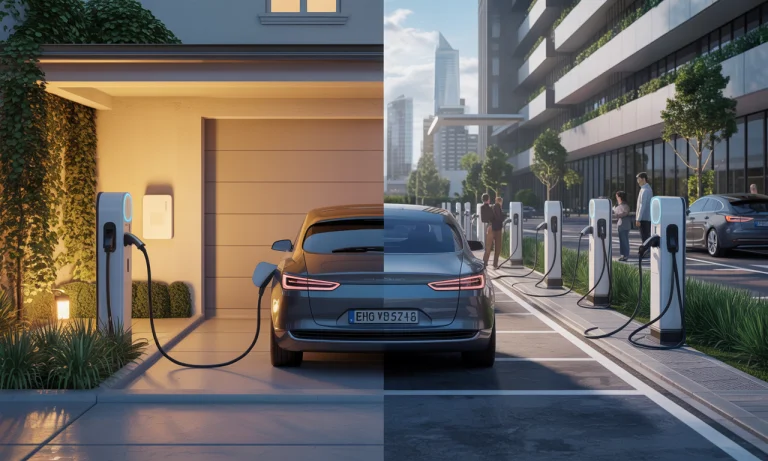Picture this: the hum of an electric vehicle winding through suburban streets as dusk settles. For Michael, who just switched from gasoline to electric, the daily question is no longer “where’s the cheapest gas station?” but “should I plug in at home or trust the public fast chargers in town?” With the United States now home to over three million EVs, this is not a solitary curiosity—it’s a defining aspect of modern commuting. The debate between home and public charging is colored by access, cost, advancements from players like Tesla and Electrify America, and how lifestyle intersects with evolving infrastructure. Whether drivers live in a high-rise using Blink Charging or a solar-powered house with a JuiceBox in the garage, choosing the right charging strategy means more than plugging in—it’s about plotting autonomy on the open road.
Electric Vehicle Charging: Understanding the Essentials Before You Plug In
Charging an electric vehicle requires more than just a cable and a power source—it’s about understanding the dynamics behind every added mile. The landscape is divided among Level 1 (standard wall outlets), Level 2 (240V setups), and public DC fast charging stations. Imagine Sarah, who commutes daily for work, relying primarily on a home-based Level 2 ChargePoint installed in her garage. Every night, she plugs in, trusting the reliable stream of power. Meanwhile, her neighbor, Jack, opts to rapid-charge his new Tesla Model Y at a Shell Recharge station nearby on busier days. While home chargers provide consistent access, unlocking advanced features such as solar synchronization from JuiceBox units or vehicle-to-grid technology from Siemens, public DC stations like those operated by EVgo and Electrify America offer exceptional convenience for road trips—just at a higher cost and sometimes with longer waits. The fundamental split is not just technical; it’s a question of daily rhythm and long-term planning, shaping the way America’s cities and suburbs recharge.
How Charging Levels Compare: Practical Impact on Your Everyday Routine
As electric car adoption swells, drivers experience the contrasts in charging speeds firsthand. Home Level 1 charging, though simple, can mean a slow trickle—just enough for those who rarely travel far. When Michael upgraded to a Level 2 Volta system, his range per hour soared, transforming overnight charging into a viable daily solution. On the other end of the spectrum, DC fast chargers like those at ABB-equipped public plazas can deliver hundreds of miles’ range in the time it takes to sip a coffee. Yet not every EV, from the latest Hyundai Ioniq to iconic Tesla models, supports ultra-fast charging, and frequent use of rapid chargers can impact battery longevity. Comparing these three levels underlines not just their technical capacity but the way they reshape habits: gradual replenishment at home versus a burst of energy on the road.
| Charging Level | Typical Location | Range Added/Hour | Installation Cost | Best For |
|---|---|---|---|---|
| Level 1 (120V) | Home | 3-5 miles | Low/None | Minimal daily use |
| Level 2 (240V) | Home/Public | 14-75 miles | $1,200-$2,500 | Daily commutes |
| DC Fast Charging | Public | 173-298 miles | High (Station only) | Long trips, quick top-up |
Cost Analysis: Weighing Home vs. Public EV Charging for Smart Drivers
Money talks—and for EV drivers, so does every kilowatt hour. Consider Emma, a homeowner in Phoenix, who installed a JuiceBox for $1,800 and now enjoys near-wholesale electricity rates, often dipping below $0.10 per kWh at night. With her typical driving patterns, annual charging costs rarely surpass $700. Meanwhile, for those without easy home access—urban renters, apartment dwellers—public stations from Blink Charging and Electrify America become lifelines. Here, users pay variable rates: $0.20–$0.25 per kWh for Level 2, up to $0.60 per minute for DC fast charging. EMC billboards in Washington, D.C., highlight Electrify America’s latest non-member rates: a full battery for Michael’s Chevy Bolt could top $34. Even memberships offer modest relief. For routine long-distance drivers or those living in charging deserts, the price differential can be significant, sometimes surpassing the cost savings typically associated with going electric—though new federal credits on installations and fluctuating grid prices may tip the balance. Tracking these costs week by week becomes its own financial strategy, especially as new charging providers like Shell Recharge and ABB enter the market.
| Scenario | Estimated Annual Cost | Key Players | Notes |
|---|---|---|---|
| Home Charging (Level 2) | $600-$800 | JuiceBox, ChargePoint, Siemens | Upfront installation offset by low rates |
| Public Level 2 | $800-$1,200 | Blink Charging, Volta | Pay-per-session; may increase with usage |
| DC Fast Charging | $1,000-$1,800 | EVgo, Electrify America, Shell Recharge | High speed, higher per-session cost |
Convenience and Reliability: The Real-World Experience of EV Owners
For residents with a driveway and an outlet, the allure of waking up to a full battery is undeniable. That’s what motivated Michael to invest in a Siemens wall box—a personal power station, untroubled by peak times or software glitches. Yet, for millions whose homes offer no such privilege, reliability is defined by the reach and health of the public network. As more drivers take to the highways, availability becomes the new gold. Jack’s routine now involves checking Volta app maps for open ports and planning weekend getaways around the fastest Electrify America chargers. Still, broken plugs, queueing at popular EVgo stations, and patchy coverage—especially in rural swathes—remind drivers that infrastructure expansion has yet to match ambition. Despite rapid network growth, home setups continue to win in reliability, while public options are catching up thanks to national investments and brands like ABB and Shell Recharge pushing deployment further.
Technology and Future-Proofing: Innovations Shaping the Charging Landscape
The EV charging ecosystem is never static. Innovations are reshaping both home and public stations. The latest Tesla Superchargers boast near 1000 kW peaks for the brand’s newest models, although such power dwarfs most mainstream options. Conversely, home units like ChargePoint’s Home Flex now integrate with smart grids, enabling cars to sell stored energy back during peak hours or coordinate overnight charging with dynamic electricity tariffs. Public fast chargers powered by ABB are leveraging AI for predictive load management, and Blink Charging’s urban installations are increasingly solar-powered. And with alternative fuels, like Shell’s new EV fluid technology promising 50% faster charge times, the performance gap is narrowing. Owners must now consider compatibility: while every current EV uses the J1772 plug for Levels 1 and 2, not all models—especially legacy cars—can capitalize on the highest DC outputs. The market’s direction hints at a future where charging, energy storage, and grid management blend seamlessly, as highlighted by innovations from Siemens and JuiceBox.
Charging Access and Social Implications: Who Gets to Charge Where?
The question of “where to charge” is as much about policy and design as it is about hardware. In cities like Boston and Atlanta, public investment is reshaping accessibility: more Volta and Blink Charging units dotting street corners, and multi-unit dwellings required to upgrade their power supplies. Yet, disparities remain. Data suggests rural areas still lag, with drivers relying heavily on a few steadfast Shell Recharge or Electrify America outposts for cross-state travel. Even in tech-forward locales, demand can outpace supply, leading to tales of drivers queuing for a free spot or finding only out-of-service stations. Looking ahead, partnerships—like those between local governments and ABB—are bridging gaps, while apps coordinate sessions to reduce congestion. Since 2025 marks an inflection point, as highlighted in discussions at Left Lane News, equal access is recognized not just as a technical hurdle but as a social mandate. The real test for future mobility: no driver left behind, regardless of zip code.
Frequently Asked Questions on Electric Car Charging Choices
Is it cheaper to charge an electric car at home or at a public station in 2025?
Home charging generally offers a lower per-kWh rate, especially when taking advantage of off-peak or solar energy, making it most cost-effective for those with private parking and the means to install a Level 2 unit. However, upfront installation costs should be considered. Public stations, such as those from Electrify America or EVgo, tend to have higher per-session rates, particularly for DC fast charging, impacting long-term expenses for frequent users. More details on current price dynamics can be found at Left Lane News.
Which companies are the leading providers of EV charging solutions?
Several companies dominate the charging landscape: ChargePoint, Tesla, EVgo, Blink Charging, Shell Recharge, Electrify America, Volta, JuiceBox, Siemens, and ABB. Each offers unique solutions, from rapid urban charging to integrated home energy management. Technologies and partnerships among these players are shaping future infrastructure, as explored in this industry update.
Are there incentives for installing a home EV charger?
Yes—many regions offer tax credits or rebates, often covering up to 30% of installation costs for Level 2 chargers. These financial incentives help offset upfront costs, making home setups more attainable. For specifics about local programs, check resources like Left Lane News and your municipality’s renewable energy incentives.
How reliable are public charging networks today?
Public networks from providers like ABB, Electrify America, and Blink Charging have become more robust, but challenges remain: outages, maintenance downtime, and uneven station availability can disrupt travel plans, especially during peak times or in less-served locales. Strategic route planning and using multiple apps like ChargePoint or Volta can help increase reliability—a theme discussed further here.
What should first-time EV buyers consider when choosing between home and public charging?
Key considerations include daily driving distance, access to home parking and electrical capacity, proximity to public chargers, and overall lifestyle. Those able to invest in home charging often find it more convenient and economical. For urban dwellers, public networks make EV ownership feasible but may require more planning. Check this buying guide for new car buyers at Left Lane News.
Did you like it? 4.4/5 (22)







